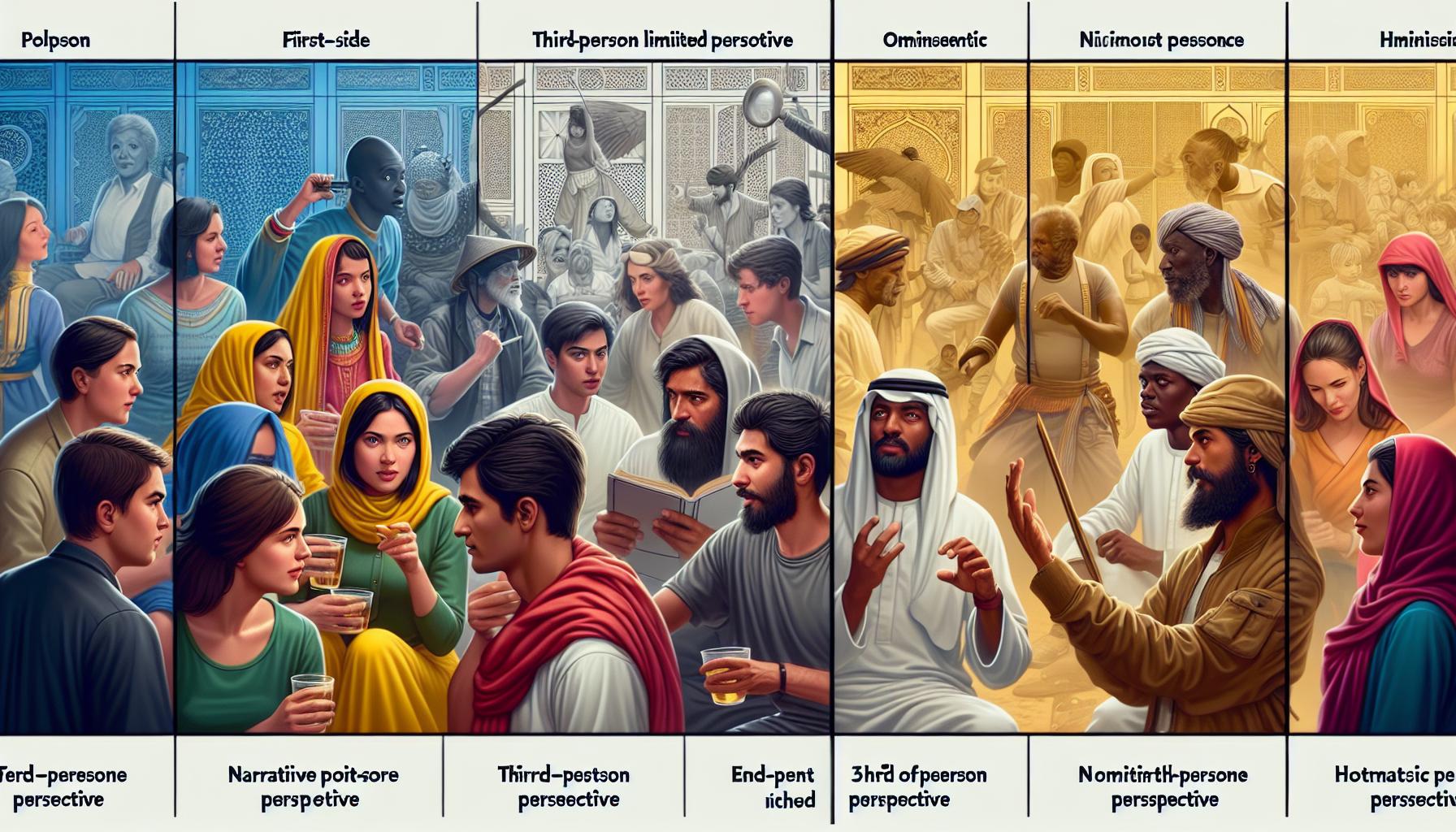Writing a story without choosing the right point of view is like trying to drive blindfolded – you might get somewhere, but it probably won’t be where you intended. Point of view (POV) serves as the lens through which readers experience a story and shapes how they connect with the characters and events.
Whether it’s the intimate first-person perspective that lets readers crawl inside a character’s mind or the all-seeing eye of third-person omniscient that reveals multiple characters’ thoughts, selecting the appropriate POV can make or break a story’s impact. It’s not just about choosing between “I” and “he/she” – it’s about determining how much information readers receive and how they’ll experience every twist and turn of the plot.
Understanding Point of View in Fiction Writing
Point of view determines how readers experience a story’s events through specific narrative filters. Three primary POV options exist in fiction writing: first person (“I”), second person (“you”), and third person (“he/she/they”).
First-person POV creates intimate storytelling through a character’s direct thoughts and experiences:
- Characters reveal personal emotions and internal conflicts
- Readers access limited information based on narrator knowledge
- Narrative maintains authenticity through single perspective limitations
Third-person POV offers flexible storytelling approaches:
- Limited perspective focuses on one character’s thoughts and experiences
- Omniscient perspective reveals multiple characters’ perspectives and motivations
- Objective perspective presents external observations without internal character insights
Second-person POV places readers directly in the story:
- Narrative addresses readers as “you” throughout the text
- Interactive storytelling creates immediate engagement
- Complex execution requires careful consideration of reader immersion
Each POV choice affects critical story elements:
- Character development and relationship dynamics
- Plot progression and information revelation
- Narrative tone and emotional impact
- Reader connection with protagonists and antagonists
| POV Type | Narrative Distance | Information Access | Reader Connection |
|---|---|---|---|
| First Person | Closest | Limited | Direct/Personal |
| Second Person | Direct | Variable | Immediate |
| Third Limited | Moderate | Single Character | Focused |
| Third Omniscient | Distant | Complete | Broad |
POV selection influences narrative techniques, dialogue presentation and scene descriptions. Writers match POV with genre conventions and story requirements to create effective fictional worlds. Modern fiction explores POV combinations to develop unique narrative experiences.
How Point of View Shapes Story Experience

Point of view functions as the lens through which readers experience a story’s events, emotions, and revelations. The chosen perspective creates distinct pathways for reader engagement and information delivery.
Creating Reader Connection
First-person POV creates immediate emotional bonds by placing readers inside a character’s thoughts and feelings. Readers experience events alongside the protagonist, sharing their triumphs, failures, and internal struggles. Third-person limited POV maintains psychological closeness while providing additional context through external observations. Omniscient narration builds broader connections by revealing multiple characters’ perspectives, though at the cost of intimate character bonds. Second-person POV generates unique reader engagement by making the audience an active participant in the story.
Controlling Information Flow
POV determines the scope and timing of information revealed to readers throughout the narrative. First-person narrators filter all information through their limited knowledge and personal biases. Third-person limited restricts information to a single character’s perspective while allowing objective descriptions of their actions and appearance. Omniscient narration provides complete access to all characters’ thoughts and motivations, enabling complex plot development across multiple storylines. Strategic POV selection creates suspense through calculated information restriction or builds dramatic irony by revealing details unknown to specific characters.
| POV Type | Connection Level | Information Access |
|---|---|---|
| First Person | High Intimacy | Limited/Biased |
| Third Limited | Moderate Intimacy | Focused/Objective |
| Omniscient | Broad Understanding | Complete Access |
| Second Person | Direct Involvement | Variable |
Major Types of Point of View
Point of view in fiction encompasses distinct narrative perspectives through which stories unfold. Each type shapes the narrative’s accessibility, intimacy, and impact on readers.
First Person Narrative
The first-person narrative positions a character within the story as the narrator, using pronouns like “I” and “me.” This perspective creates immediate intimacy by filtering events through the narrator’s direct experiences, thoughts, and emotions. Popular examples include “The Catcher in the Rye” by J.D. Salinger and “The Great Gatsby” by F. Scott Fitzgerald. The narrator shares personal observations, biases, and interpretations while limiting readers to information available to that character. This restriction adds authenticity to the storytelling but introduces potential unreliability in the narrative voice.
Third Person Limited
Third-person limited focuses on one character’s perspective while maintaining narrative distance through pronouns like “he,” “she,” or “they.” This POV provides access to a single character’s thoughts and feelings while describing external events objectively. Books like “Harry Potter” by J.K. Rowling demonstrate how this perspective balances intimate character insights with broader storytelling flexibility. The narrative remains close to the focal character while allowing descriptions of events beyond their immediate awareness.
Third Person Omniscient
Third-person omniscient narration offers complete access to multiple characters’ thoughts, feelings, and motivations simultaneously. This perspective uses third-person pronouns while moving freely between different characters’ viewpoints. Classic novels like “Pride and Prejudice” by Jane Austen showcase how omniscient narration reveals complex relationship dynamics and social commentary. The narrator possesses full knowledge of past, present, and future events, providing comprehensive insight into the story world and its inhabitants.
| POV Type | Narrative Distance | Information Access | Character Insight |
|---|---|---|---|
| First Person | Closest | Limited | Deep/Single |
| Third Limited | Moderate | Focused | Deep/Single |
| Omniscient | Distant | Complete | Broad/Multiple |
Impact of POV on Character Development
Point of view fundamentally shapes how characters evolve throughout a narrative. The chosen perspective determines the depth of character insight readers receive.
Internal vs External Perspectives
Character development in first-person POV reveals intimate thoughts, feelings, memories through direct internal monologue. Third-person perspectives create distance between readers and characters, presenting development through observable actions, dialogue patterns, interactions with others. First-person narrators expose their growth directly through self-reflection, while third-person limited POV balances internal understanding with external observation of a single character. Omniscient narration provides comprehensive development across multiple characters but sacrifices deep psychological connection. Each perspective choice affects how readers track character arcs, understand motivations, witness transformative moments.
Character Voice and Authenticity
POV selection directly influences a character’s distinct voice and authentic representation. First-person narrators speak directly to readers, showcasing unique speech patterns, vocabulary choices, cultural backgrounds through unfiltered thoughts. Third-person perspectives establish character voices through selective internal access, dialogue exchanges, behavioral descriptions. Limited perspectives maintain authentic character development by focusing on individual growth journeys. Omniscient narration creates authenticity through contrasting multiple character voices, revealing how each personality uniquely responds to story events. Voice consistency strengthens character credibility regardless of chosen POV.
How POV Affects Plot and Pacing
Point of view shapes the rhythm and momentum of a story by controlling information flow and reader engagement. The chosen perspective determines how events unfold and how readers experience the narrative journey.
Managing Tension and Suspense
POV creates dramatic tension through strategic information control. First-person narration builds suspense by limiting readers to one character’s knowledge, creating uncertainty about other characters’ motives or actions. Third-person limited POV generates tension by revealing selective thoughts while withholding crucial information from both the focal character and readers. Omniscient narration crafts suspense by showing multiple character perspectives, allowing readers to anticipate conflicts before they occur. Writers use POV shifts in multi-perspective novels to heighten tension at pivotal plot points, such as switching viewpoints during climactic scenes or revealing parallel events through different characters’ eyes.
Revealing Key Story Elements
POV dictates the timing and method of plot revelations. First-person narrators unveil story elements through direct experiences, personal discoveries or conversations with other characters. Third-person limited perspective introduces plot points through a single character’s observations combined with narrative exposition. Omniscient POV presents story elements through multiple viewpoints, weaving together different character arcs to create a complex narrative tapestry. Writers reveal mysteries, conflicts or character relationships based on their chosen POV’s natural limitations. Each perspective offers distinct tools for plot advancement: internal monologues in first-person, focused external observations in third-person limited or comprehensive story-world knowledge in omniscient narration.
Choosing the Right POV for Your Story
Selecting an appropriate point of view aligns the narrative perspective with the story’s requirements. The chosen POV creates a foundation for effective storytelling by establishing how readers connect with characters and events.
Genre Considerations
Different genres come with distinct POV expectations. Romance novels often employ first-person or third-person limited perspectives to deepen emotional connections. Mystery stories utilize first-person narration to restrict information access creating suspense. Fantasy epics frequently use third-person omniscient POV to showcase complex world-building elements. Horror stories leverage first-person POV to heighten fear through immediate experiences. Literary fiction experiments with multiple POVs to explore complex themes. Young adult fiction favors first-person present tense to create immediacy for teenage readers. Historical fiction benefits from third-person POV to provide contextual details about past events.
Story Goals and Themes
POV selection amplifies story themes through specific narrative techniques. First-person narration emphasizes personal growth themes by revealing internal struggles. Third-person limited POV explores isolation themes by showing restricted perspectives. Omniscient narration examines social themes by revealing multiple viewpoints. Complex moral themes benefit from alternating POVs to show conflicting perspectives. Coming-of-age stories gain authenticity through first-person teenage voices. Political narratives use third-person omniscient to expose power dynamics. Family sagas employ multiple POVs to showcase generational differences. Psychological thrillers leverage unreliable first-person narrators to question reality.
Conclusion
Determining the point of view in fiction writing stands as a cornerstone of effective storytelling. The chosen perspective shapes every aspect of the narrative from character development and plot progression to reader engagement and emotional connection.
Writers who carefully select their POV create more immersive and cohesive stories that resonate with their audience. Whether choosing the intimacy of first person the versatility of third person or the unique impact of second person the right POV serves as the foundation for delivering a compelling narrative experience.
Success in storytelling ultimately depends on matching the chosen POV with the story’s needs genre expectations and intended impact on readers. A well-chosen perspective transforms good writing into unforgettable storytelling that captivates audiences and brings fictional worlds to life.
